11
Aug
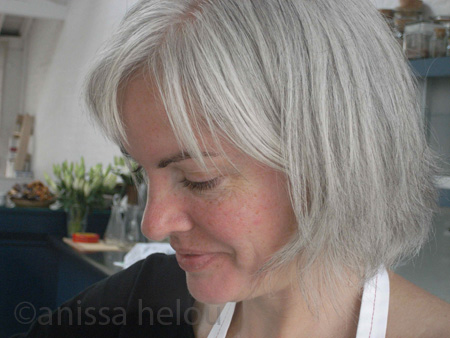
Very soon I will be going to California for WOF which theme this year is Arc of Flavors. I am looking forward to the conference of course but I also can’t wait to see my newly-engaged nephew and his fiancee and my niece and all my friends including lovely Amy, who as some of you may know, helped me cook my birthday party. I love cooking with Amy. Not only is she a marvellous chef (at Chez Panisse) but she is also a fabulous partner in the kitchen with the sweetest character and no ego in play; and she is very silent as she works — I am totally paranoid about noise. And to make things even better, Amy loves my Lebanese food as much as I love hers. So, when we saw the fresh borlotti beans at la Fromagerie, I told her about my mother’s fassulia (beans in arabic) bil-lahmeh (meat), and how she used to prepare it with pork skin in a tomato sauce. As luck would have it, I had received that morning wonderful pork belly from Packington Free Range farm. So, we decided to buy the beans to cook with the pork.
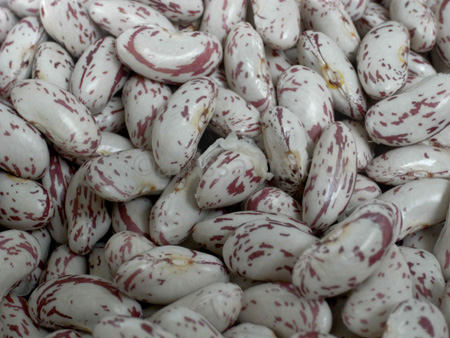
I gave Amy my Lebanese cookbook for her to look at the recipe before we could discuss how to prepare the dish slightly differently to avoid the beans becoming mushy and have an elegant presentation (which sadly you will not be able to see because I forgot to photograph the final dish which did look beautiful!). We decided to start more or less the way my mother does and as you can see from the picture below, Amy sliced the onions beautifully.

As for the meat, the butcher at Packington had already scored the skin in little squares for maximum crispness which was very clever.
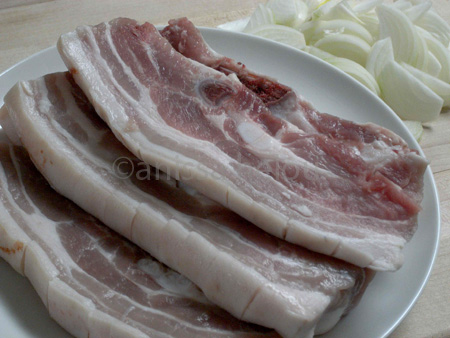
And this is when Amy surprised me by cooking the slices vertically with the skin down to crisp it up before searing the meat. Incredibly good tip which I will not only use but also pass on to my mother who is bound to appreciate it.
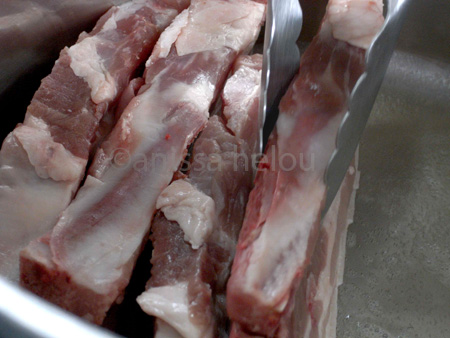
As you can see, it was a very good idea.
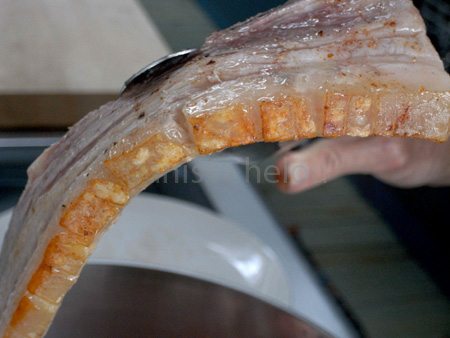
Then Amy seared the meat and removed it onto a plate to sauté the onions.

And here is when Amy started veering away from my mother’s version. She added garlic (fresh, also from la Fromagerie) to the onion and cooked the meat completely with the seasonings but not the tomato concentré.
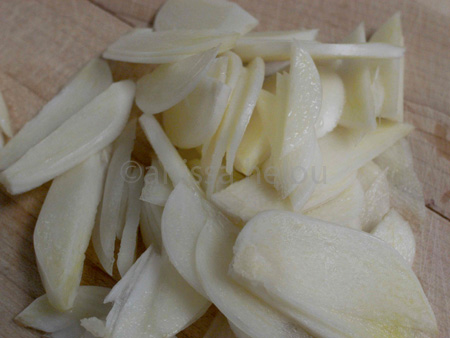
Amy then strained the meat and onions and placed the cooking broth in the refrigerator to make it easier to defat. she skimmed the broth and cooked the beans in it until they were just done (about half an hour) before adding the meat and tomato concentré. Here again, Amy changed my mother’s recipe and used a lot less tomato concentré. By the end the broth had reduced to a thick sauce and all the flavours had melded together to resemble my mother’s albeit more subtle!
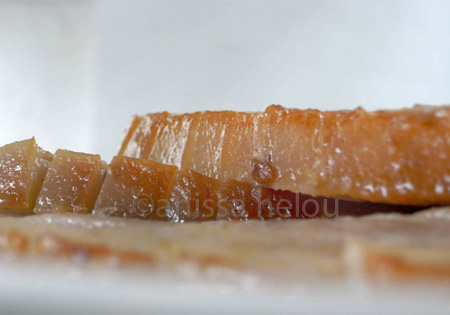
Here is my mother’s recipe but as much as I love her, I have to say I prefer Amy’s version and I am only sorry that I was so taken by our guests that night that I forgot to snap the final dish which Amy made look gorgeous. By the time I remembered, It was too late and all that was left was scraps but here is a snap of the beautiful golden skin which I hope will make up for my attention lapse!
Serves 4
250 g dried cannellini or haricot beans, soaked overnight in plenty of cold water with 1 teaspoon bicarbonate of soda (or 500 g fresh borlotti beans)
500 g pork meat from the hand and spring joint or lamb meat from the shoulder
2 or 3 bones (optional)
60 g unsalted butter
1 large onion, sliced medium-thin
140 g tomato concentrate
1 teaspoon ground cinnamon
1 teaspoon ground allspice
½ teaspoon finely ground black pepper
¼ teaspoon ground nutmeg
sea salt
If you are using pork and intend to cook the skin with the meat, singe it first over a gas fire to get rid of any fluff. Rinse the meat under cold water and cut it in chunky pieces, separating the skin from the meat (if the skin is very fatty cut off and discard any excess fat). If you are using lamb, strip the skin off, discard it, and get rid of as much fat as you can and cut as with the pork.
Melt the butter in a saucepan over a medium heat and sauté the pork skins (if you are using them) until crisp and golden. Remove them onto a plate and brown the meat. Remove the meat onto the same plate as the skins. Add the sliced onion and cook, stirring occasionally, until soft and transparent. If you are using the bones, rinse them under cold water before adding to the onion. Sauté the bones until they lose all traces of pink. Return the skins and meat to the pan, add 1 litre water, cover and bring to the boil. When the water is about to boil, skim the surface clean and boil gently for 15 minutes.
Drain the soaked beans and rinse them under cold water. Add to the meat and onion and boil gently, covered, for 45 minutes or until the beans are tender (if you are using fresh beans, cook the meat for 15 minutes longer then add the beans).
Dilute the tomato concentrate in a little water and stir into the broth. Season with cinnamon, allspice, pepper, nutmeg and salt to taste, put the lid back on and simmer for 10 more minutes or until the sauce has thickened and the beans are cooked. Taste, adjust seasoning if necessary, and serve hot with plain rice.
©anissa helou from Lebanese Cuisine
Tagged : amy dencler, borlotti beans, chez panisse, fassulia, fassulia bil-lahmeh, la fromagerie, lebanese bean stew, lebanese cuisine, packington free range, pork belly, pork skin, searing pork skin, World of Flavors conference ![]() 10
10

There is 10 comments on this post
Warning: Undefined array key 36 in /data/40/0/131/109/783598/user/802494/htdocs/anissahelou/wp-content/themes/Anissa/functions.php on line 377
August 12, 2012 at 7:47 am
It’s funny: fassulia in Arabic, pasul, with the accent on the u, in Serb, which is the main staple of the country people – and of the soldiers, of course. It’s a stew of borlotti beans, obviously inherited from the Ottomans, with pieces of meat, mostly pork, now very Arabic, since they are Christians of the Orthodox denomination…
Warning: Undefined array key 36 in /data/40/0/131/109/783598/user/802494/htdocs/anissahelou/wp-content/themes/Anissa/functions.php on line 377
August 12, 2012 at 7:51 am
very interesting. is it pasül or pasûl? must check it out 🙂
Warning: Undefined array key 36 in /data/40/0/131/109/783598/user/802494/htdocs/anissahelou/wp-content/themes/Anissa/functions.php on line 377
August 16, 2012 at 2:07 pm
Oh my God ! …
Je suis vraiment désolé Amy et Anissa, mais plus je lis cette recette, plus je pense au cassoulet…
Pour moi, une vraie Fassulia Bil-Lahmeh, c’est d’abord, de l’agneau (du chevreau si possible, car je vois que tu affectionnes particulièrement cette viande très goûteuse mais, très spéciale…Un vrai met de connaisseur et d’initiés. L’été dernier, j’ai vu une émission “Fourchette et sac à dos”…Je crois, où tu présentais cette délicieuse viande préparée par une famille bédouine au Liban).
Donc, pour moi, qui tiens cette recette, moi aussi, de ma mère…. une Fassulia Bil-Lahmeh est un plat où il est question de Haricots blancs, d’oignons, d’ail, de la sauce tomates, de la viande d’Agneau (Collier, poitrine, épaule…). Je ne sais pas pourquoi, mais ce plat (à base de féculant) est toujours servi avec du riz (un autre féculant)…Chose inconcevable en Occident, mais, en Palestine, ou en Jordanie…C’est toujours ainsi.
J’ai lu avec beaucoup d’attention le message de Aliosha. Il se trouve, que ma mère (Palestinienne) est d’origine Bosniaque. Ses arrières grands parents, convertis à l’Islam, sous l’Empire Ottomane, ont du quitter la Bosnie pour venir s’exiler en Palestine. C’est là que, quelques années plus tard, mon père, palestinien, a rencontré sa future femme, blonde aux yeux bleus…et qui parlait le yougoslave.
Revenons donc à la Fassulia Bil-Lahmeh…D’après mon enquête, il paraît que l’origine du cassoulet est arabe…Ce n’est pas moi qui le dit mais, ce sont les dépositaires officiels de ce Grand plat qui le laisse entendre: http://www.confrerieducassoulet.com/lhistoire.html
Et toujours, suite à mon enquête, et pour poursuivre avec le message de mon amie Aliosha, les Ottomanes ne pouvaient pas être les seuls colporteurs de la légende “Haricots” car, les haricots, originaires du continent sud-américain, ont été introduits en Europe bien avant (XVIe siècle). En Europe, il s’agit donc plus probablement de fèves ou de doliques (Moujette ou mounjette en occitan) qui étaient consommées à l’époque en ragoût.
Bon, j’arrête là car je doit aller mettre à tremper mes haricots blancs pour faire une “Fassulia Bil-Lahmeh”.
Merci, Anissa, pour cette bonne idée.
Nidal
Warning: Undefined array key 36 in /data/40/0/131/109/783598/user/802494/htdocs/anissahelou/wp-content/themes/Anissa/functions.php on line 377
August 16, 2012 at 2:27 pm
en effet ma mere presente la fassulia avec du riz (peut etre mem le rezz bil-sh’ayriyeh) et je l’aime comme ca aussi mais la, on essayait d’etre elegante et plutot minceur! j’adore la version avec le porc que ma mere faisait au liban. peut etre c’est tres montagne chretienne (ma mere est de rechmaya du cote de sa mere et b’hamdun du cote de son pere) mais ca fait tres longtemps qu’elle ne la fait plus avec du porc mais avec de l’agneau. j’espere que ta fassulia etait tres bonne :).
Warning: Undefined array key 36 in /data/40/0/131/109/783598/user/802494/htdocs/anissahelou/wp-content/themes/Anissa/functions.php on line 377
August 16, 2012 at 3:14 pm
“J’espère que ta fassulia etait très bonne 🙂 .”
C’est pour demain soir, Anissa.
Ce soir je ne fais que les laisser tremper dans de l’eau les haricots blancs Bio achetés ce midi (suite à la lecture de ton blog !) et sans bicarbonates…Ainsi, j’ai la promesse d’un temps de cuisson plus important, voire interminable…, avec des odeurs et des arômes qui envahissent la cuisine pendant des heures et des heures. Ces moments, que j’essaies de faire durer et durer un maximum de temps, sont plus importants, pou moi, que le passage à l’acte…
Ce soir, c’et moules marinières (Moules, vin blanc: Muscadet, échalotes, ail et persil) avec en amuse bouche: des truites de mer fumées, pain de seigle et beurre demi-sel (Ici, en Bretagne c’est la règle…)
Nidal
P.S.: Je tiens à te présenter, ainsi qu’à tes lecteurs, mes sincères excuses pour ces textes écrits en français. Je comprends très bien l’Anglais mais, ma pratique de cette belle langue date de très loin, maintenant…
Allez, en cadeau, je te laisse avec cette très belle chanson de Ray Davies (The Kinks) qui m’a donné la chair de poule en regardant, il y a deux jours, The Closing Cereomony of the Olympics, à Londres
http://www.youtube.com/watch?v=IXEC7RJeD5s
Warning: Undefined array key 36 in /data/40/0/131/109/783598/user/802494/htdocs/anissahelou/wp-content/themes/Anissa/functions.php on line 377
August 19, 2012 at 8:19 am
great illustration of you for Sketchbook Magazine!
http://cargocollective.com/joanneyoungillustration/Sketchbook-Magazine
Warning: Undefined array key 36 in /data/40/0/131/109/783598/user/802494/htdocs/anissahelou/wp-content/themes/Anissa/functions.php on line 377
August 19, 2012 at 8:32 am
hey thanks abdallah. i hadn’t seen it. it’s really nice 🙂
Warning: Undefined array key 36 in /data/40/0/131/109/783598/user/802494/htdocs/anissahelou/wp-content/themes/Anissa/functions.php on line 377
August 25, 2012 at 4:19 am
Marhaba Anissa,, your friends way is the way I thought most yakhni/stews are made in the Sham/Levant, at least it is in my familes from Jordan..except we never use pork!..trimmed lamb shoulder or beef..We always saute the onions and garlic with the spices after the browning of the meat , so that the spices bloom and release their oils into the meat and resulting broth..then once the broth is skimmed we add fresh very ripe peeled and seeded tomato or paste if in a pinch..then finally we add the beans or vegetable… oh my my mouth is watering..wish u had pics of the final dish!
Warning: Undefined array key 36 in /data/40/0/131/109/783598/user/802494/htdocs/anissahelou/wp-content/themes/Anissa/functions.php on line 377
August 25, 2012 at 4:38 am
sorry i dont know if i got my point across…what im trying to say in a nutshell is we never spice at end of cooking like in your moms recipe..perhaps that is why u found chef Amys more subtle?
Warning: Undefined array key 36 in /data/40/0/131/109/783598/user/802494/htdocs/anissahelou/wp-content/themes/Anissa/functions.php on line 377
August 25, 2012 at 4:43 am
no it wasn’t. it was because she cooked the meat and beans separately and only mixed them at the v end, and the subtlety was cos she used less tomato paste. yes, it was a shame i forgot to photograph the final dish. it was gorgeous 🙂